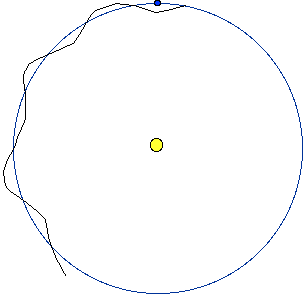
Viewed from Polaris, the moon orbits the sun wiggling about the orbit of the earth, which is blue.
The Three Moons of Earth
The Moon
The Earth's Moon orbits with a sidereal period of 27.32 days.
But in reality the moon co-orbits the sun with the earth. The force of gravity of the sun on the moon is greater than the force of gravity of the Earth on the moon. In fact it is just about double.
A brief optional mathematical interlude.
Fgsun = GMmoonMsun/R2sunFgearth = GMmoonMearth/R2earth
so the ratio is
Fgsun /Fgearth = MsunR2earth/MearthR2sun
= 2 x 1030 (3.8 x 108)2 / 6 x 10 24 (1.5 x 1011)2
= 2.1
Viewed from polaris (the pole star) the moon orbits the sun always moving around counterclockwise it never turns around to go the other way. The moon's orbit is concave to the sun, always. More concave outside the earth's orbit, less concave inside. The moons orbits snakes around inside the earth behind the earth outside the earth and in front of the eart.

Yet, from the point of view of a person standing on the earth the moon appears to orbit the earth in an approximately circular orbit. There is no doubt that the Moon is a mon of earth. A large natural satellite.
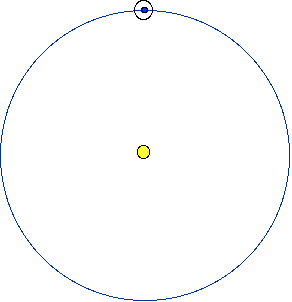
Astronauts left laser reflectors on the moon. Scientists bounce lasers off of these reflectors and measure precisly (to within a few centimeters).These measurements show that the moon's orbit is increasing in radius by about 3.8 cm/yr. The Moon has moved 3000 km further away over the last 900 million years. At the same time, the earth's rotation rate is slowed adding an extra second to the length of the year, almost every year.
Orbits
Before we learn about other possible moons of earth it will help to do a few experiments with orbits. Return to orbits.
Cruithne
In 1986 D. Waldron in Australia discovered a 5 km diameter companion to Earth a co-orbital near Earth asteroid. He named it 3753 Cruithne, pronounced Crueenya, after a Celtic tribe also known as the Picts. It has a very strange orbit about the sun which is elliptical and sweeps in passed Venus almost to mercury and then out almost to mars. One orbit takes almost exactly a year. It is choreographed so that the orbit is stable and Cruithne will never strike the earth.
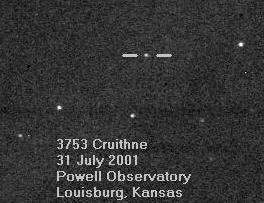
It takes one year for Cruithne to orbit the sun, as does the Earth and the Moon.
Just as the moons orbit is transformed from a sinusoidally wiggling ellipse about the sun into a nearly circular orbit of the earth when viewed in the earth frame of reference, so to does Cruithne's orbit present an interesting pattern when viewed from a reference frame attached to the earth. (The transformation from the sun frame to the earth frame is well shown in a movie on Paul Wiegert's site.) When viewed from a point above the north pole of the earth the asteroid Cruithne follows a type of complex horseshoe orbit.
A Simple Horseshoe Orbit
Let's consider a simple horseshoe orbit of a mythical asteroid Pegasus first. Pegasus is realy in a nearly elliptical orbit about the sun, but viewed from the earth's frame it's orbit is shaped like a horseshoe. Sometimes Cruithne orbits the sun slightly closer than the earth does, at these times it catches up with the earth. When it comes close to earth its orbit is perturbed and it is moved to a larger radius orbit where it orbits slower than the earth. It falls behind in its orbit until the earth catches it and transfers it to the inner orbit once again.

In the horseshoe orbit shown above, the black satellite of the sun, Pegasus, catches up with the earth in an inner faster orbit, it is given energy by the gravitational pull of the earth and moves into a larger radius slower orbit. It then falls behind the earth until once again it encounters earth. This time the earth removes energy from the satellite dropping it in to a lower faster orbit where it circles back to the original position. Even though the earth and the mythical satellite Pegasus go around the sun once each year in this reference frame that co-rotates with the earth the satellite can takes hundreds of years to complete the horseshoe. It looks like the eart's gravity is repelling the satellite. But it isn't.
It's like cars on a circular race track with the inner cars traveling faster and the outer cars traveling slower. The earth stays in the middle lane while Pegasus shifts from inner lane to outer lane and back again every time it encounters the earth. Catching the earth when its in the inside lane, falling behind in the outside lane.
I would not call Pegasus a mon of the earth since it never actually passes around the earth in the earth's frame.
It's More complicated than that.
Cruithne orbits the sun in an ellipse once a year, viewed from the earth this ellipse becomes a kidney bean shape. Viewed from the earth, Cruithne makes a kidney bean shaped loop once a year.The ellipse of Cruithne slowly changes its orientation from year to year, viewed from the earth's frame, the kidney bean drifts around the sun, wrapping around the earth, then slowly drifting around to circle the earth from the other side and finally after 385 years returning to the original loop around the earth. this orbit drifts creating a horseshoe returning to its original kidney bean in 385 years.
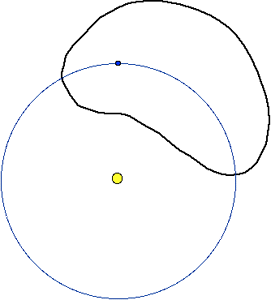
Cruithne's orbit over a year in a reference frame orbiting with the earth.
Each year Cruithne's orbit drifts around relative to the sun. Here is its orbit during the second year.
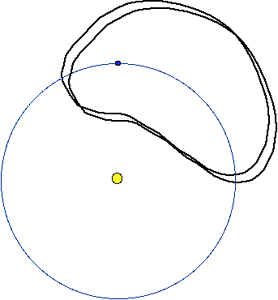
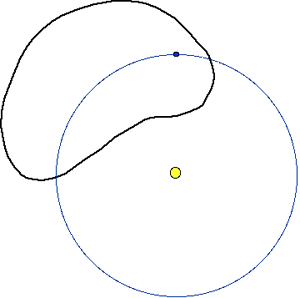
Cruithne's orbit relative to earth drifts around, after 190 years it
circles the earth from the other side.
Cruithne's orbit is actually out of the plane of the paper. On one side of its approach to earth it loops around below the earth. Right now, in autumn of 2003, it is passing over the earth's south pole. Its closest approach to earth is 0.1 AU, 1.5 x 10^7 km, 40 times the moon's orbital distance. Even at its closest it's hard to see, shining in reflected sunlight at magnitude 15. Since it does loop around the earth as viewed from the earth it does have a claim to being the earth's second moon.
The earth's orbital radius averages 1.0 AU by definition, Cruithne averages 0.99778 AU.
2002 AA29
Another co-orbital asteroid in a horseshoe orbit, named 2002AA29, it is only 100 m in diameter. It comes near the earth every 95 years, most recently January 8, 2003. In another 600 years it will orbit the earth once a year, then after 50 years of orbits drift away again. It is a quasi satellite of earth at a distance of 0.2 AU. It is 100 m in radius. (It last orbited earth in 572 AD.) Viewed from the earth frame it sometimes orbits over the poles, toward and away from the sun. It thus can claim to be earth's third moon, on a part time basis.
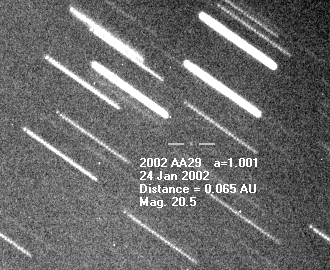
202AA29 is just big enough to fill a soccer stadium. It's gravity is so weak that a professional soccer player standing on the surface could kick a ball into orbit about the moon.
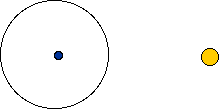
In 600 years, the orbit of 2002AA29 will make 50 yearly loops
around the earth from pole to pole.
In this drawing the blue earth is orbiting the yellow sun and is
coming straight at you. The Black line is the orbit of
AA.
More to Come.
Certainly Cruithne and 2002AA29 are just the first of many rocky bodies that will be found to orbit the sun near the earth. Many of these bodies will have orbits that will loop around the earth when viewed in the reference frame of the earth. Stayed tuned to the science pages of your newspaper to keep track of the number of new moons of earth.
Additional information.
Moons of Saturn
Epimetheus and Janus are two moons of Saturn that are nearly in the same orbit. They are co-orbital moons. Both moons are in nearly circular orbits. The inner, faster moon, gains on the outer, slower moon. The gravity of the trailing moon (which is catching up with the leading moon) pulls back on the leading moon. The gravity of the leading moon pulls the trailing moon ahead. This interaction adds energy to the trailing moon boosting it to a higher slower orbit, and takes energy from the leading moon lowering it to a faster orbit. So instead of colliding they exchange speeds and move apart. they act as if they repel one another.
Lagrange Moons
There are 5 Lagrange points where satellites can orbit at the same period as a planet. No moons have been found in the Earth's Lagrange points yet. But asteroids have been found in the lagrange points of Mars and Jupiter. around Saturn, in the orbit of its large moon Tethys there are moons Telsto ahead by 60 degrees and Calypso, behind.
Reference
|
Scientific Explorations with Paul Doherty |
|
21 August 2003 |